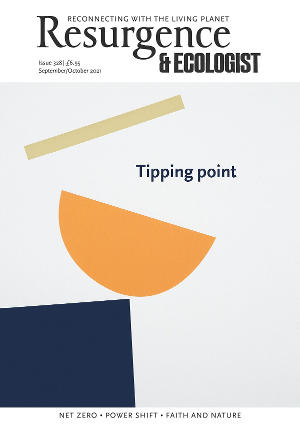When the curtains open on the 26th UN Climate Change Conference of the Parties in Glasgow on 31 October, the term ‘net zero’ will be centre stage. During the meeting, countries will be tasked with laying out emissions reductions targets that set out a clear plan to achieve net zero emissions by 2050. The decarbonisation of energy and transport, sustainable finance, protecting and restoring ecosystems – all of these need to play starring roles if this goal is going to be achieved. But will the event incentivise real change, or is it just a front for business as usual? In this section of Resurgence & Ecologist we explore what ‘net zero’ means and whether it can set the stage for a liveable future.
‘Net zero’ has become the catchphrase for politicians and businesses worldwide wanting to demonstrate their commitment to solving the climate crisis. Momentum has scaled rapidly – the UK was the first to sign the target into law in June 2019, and since then another five governments have followed suit, with the same number proposing legislation, and multiple others discussing legislation or policy. Meanwhile, in one year since it was launched, the UN-backed Race to Zero campaign has signed up more than 4,500 companies, cities, regions and financial, educational and healthcare institutions, all of whom have committed to halve emissions by 2030 and reach net zero by 2050.
But just as fast as governments and businesses are signing up to it, detractors including highly respected climate scientists and teen activist Greta Thunberg are condemning the concept as “a dangerous trap”.
What is net zero?
Net zero was enshrined in the 2015 Paris Agreement on climate change, under which countries agreed a long-term goal to limit global heating to well under 2°C above pre-industrial levels and use best efforts to reach 1.5°C, and to achieve net zero emissions by 2050.
The premise is that the world reduces its burning of fossil fuels to ever lower levels while at the same time using techniques such as carbon capture and storage and tree planting to remove the greenhouse gases already emitted into the atmosphere. Net zero is the point at which any residual emissions of greenhouse gases are balanced by technologies and natural methods of removing them from the atmosphere. It takes into account emissions that cannot be avoided, such as from cement making, where a large proportion of emissions are generated as a by-product of a chemical reaction.
Advocates of the concept include Christiana Figueres, former executive secretary of the United Nations Framework Convention on Climate Change, who has called it “our only option”. The Future We Choose, the book she co-authored with Tom Rivett-Carnac, describes a utopian world in which net zero has been achieved. (See The Stubborn Optimist, Resurgence and Ecologist Issue 320.) Without air pollution, the air is “moist and fresh”. Fertility has returned to the soil, and life to the oceans. People grow flowers and vegetables on their rooftops, and their houses have features such as green walls to absorb CO2. All the buildings generate their own energy and recycle their water, food is produced in cities, congestion is minimal, and car parking spaces have become green space.
“Reckless” approach
But prominent climate scientists, including former government chief scientific adviser Robert Watson, wrote in an article in The Conversation this year that the idea of net zero has “licensed a recklessly cavalier ‘burn now, pay later’ approach, which has seen carbon emissions continue to soar”.
Technological solutions such as carbon capture and storage, bio-energy with carbon capture and storage, and direct capture of CO2 from the atmosphere have successively been proven as mirages, they argue, for a variety of reasons, including lack of proof that they work, excessive land take and expense.
The scientists acknowledge that there is nothing in principle wrong or dangerous about carbon dioxide removal, and accept that some removal will be needed to mop up emissions from certain industries.
However, the problem comes in assuming that carbon removal – whether engineered or natural – can be deployed at a vast scale. “This effectively serves as a blank cheque for the continued burning of fossil fuels and the acceleration of habitat destruction,” they wrote.
“Current net zero policies will not keep warming to within 1.5°C because they were never intended to. They were and still are driven by a need to protect business as usual, not the climate,” their argument concludes.
Thunberg also accepted that not all emissions can be eliminated, but tweeted: “These distant net zero targets aren’t about that, rather they’re about communication tactics and making it seem like we’re acting without having to change.”
It is easy to stand this claim up when the first country to sign net zero into law, the UK, is still supporting the construction of new roads and even a coal mine.
Removing flaws
However, net zero targets have spelled out very clearly that every person and every economic sector needs to play their part. The UK’s former 2050 goal of an 80% cut in emissions left many parts of the economy believing they could come under the remaining 20% and not take any action at all. Since net zero entered the statute books, businesses have been visibly engaging more than previously.
Worldwide, net zero has created a certainty of direction for businesses that has pushed multiple major car manufacturers to announce electrification of all their models, investment in renewable energy to outweigh that in fossil fuels, and coal companies to go bankrupt.
Supporters of net zero are clear that offsetting any residual emissions is a last resort once all possible mitigation has taken place. They are also very aware of the possible flaws in the approach. Companies wishing to sign up to Race to Zero are required to meet a minimum set of criteria before they begin, which were strengthened earlier this year through a process led by the University of Oxford to clarify the need for immediate action and robust interim targets, and the requirement for carbon sinks to be used only for residual emissions.
The Science Based Targets initiative (SBTi) run by the World Resources Institute, WWF, CDP and the UN Global Compact serves as best practice for corporates who want to prove their climate credentials. The SBTi has a team of experts to independently assess and validate company emissions-reduction strategies as being in line with the latest science and sufficient to meet targets under the Paris Agreement.
So what should campaigners do to ensure that net zero becomes a genuine emissions-reduction success story rather than a vehicle for greenwash? How can net zero targets be stopped from being “loophole-friendly”, as Thunberg puts it?
Those announcing net zero targets need to ensure that they cover all emissions, are socially just, and simultaneously make immediate cuts at source, she says, while James Murray, editor of news site Business Green, suggests in a blog that 1.5°C net zero targets need to be legally binding, as do the strategies behind them. In other words, net zero, while not perfect, should not become the enemy of the good.
WALK THE TALK
Safe bike lanes and better pavements and crossings, as well as improved bicycle hire – these are all ways megacities across the world are working together to drive down emissions. The group, known as C40 Cities, is a growing network dedicated to tackling climate breakdown. Through the Walking & Cycling Network, they exchange advice on best practices and policies to support better alternatives to cars. Walking and cycling can help cities achieve 5–15% of their 2030 emissions-reduction target, according to the report ‘Focused Acceleration’. Transportation is the fastest-growing source of greenhouse gases, accounting for one third – and in some cases up to 45% – of CO2 emissions in the cities involved.
www.c40.org/networks/walking-and-cycling
POWERING ON
One poster child for the move from dirty to clean energy is the state of South Australia, which in 2020 generated 60% of its electricity from renewables. In one hour of that year, 100% of the state’s energy came from solar sources – a big change for a region that was powered entirely by fossil fuels in 2006. A report by the Institute for Energy Economics and Financial Analysis (IEEFA) attributed this success to state government policy, assisted by targets and incentives set by the federal government in 2001. It is also home to the world’s largest battery energy storage system (at the time of commissioning), which was installed in 2017. The last coal generator was closed in 2016. The state is expected to achieve its net 100% renewables target by 2025, five years ahead of schedule, and aims to reach 500% renewables by 2050, with the aim of exporting energy to neighbouring states.








